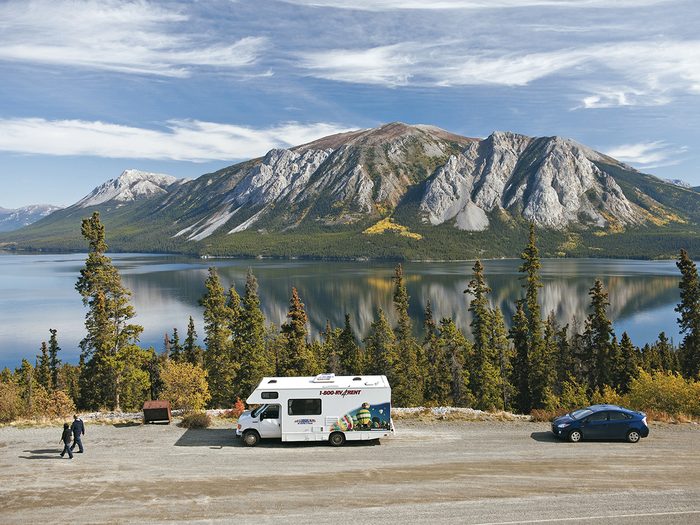
The Best Road Trips in Canada
Yukon
A trip back to the Klondike Gold Rush
We’ll kick off our roundup of the best road trips in Canada—one in every province and territory—in the Yukon.
Along the Klondike highway from Whitehorse to Dawson City, you can almost still feel the hope that brought prospectors here in search of fortune at the end of the 19th century.
In Whitehorse, the territory’s capital, visit the S.S. Klondike National Historic Site to see the largest vessel to ever navigate the Yukon River: a wooden steam-powered stern wheeler, circa 1937. Then, heading north from the city on the 715-kilometre Klondike Highway, you’ll see Lake Laberge, which the famed poet Robert Service wrote about in “The Cremation of Sam McGee.”
After passing a number of roadhouses that once served as refuges from the cold, you’ll come to Braeburn Lodge, where the cinnamon buns are as big as your head (the nearby airstrip is locally known as Cinnamon Bun Strip). Farther along, roughly 200 kilometres from Whitehorse, you can stretch your legs at the frothy Five Finger Rapids, mentioned in Jack London’s classic The Call of the Wild.
Once you reach Dawson City, spend a few days in the place where the gold-rush spirit still lives strong. Borrow a pan and try your luck at Free Claim #6, a 15-minute drive from downtown, on Bonanza Creek. For a unique evening out, head to Diamond Tooth Gerties. Open since 1971, it’s the oldest gambling hall in the country and home to Canada’s best (and, in all probability, only) cancan show.
Read on for more of the best road trips in Canada.
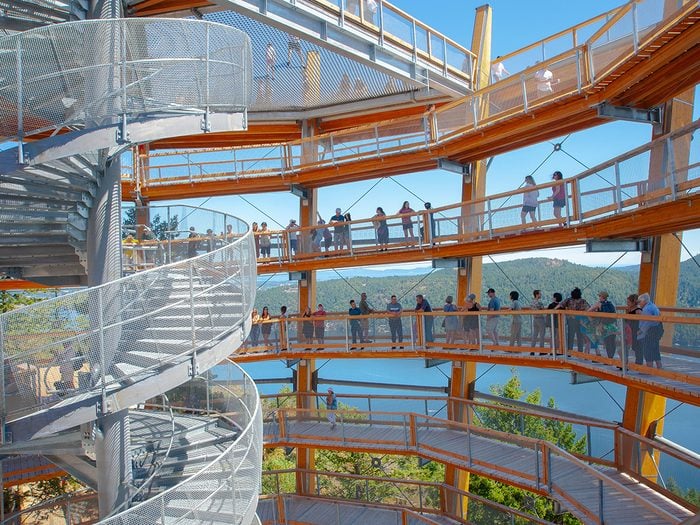
British Columbia
Beachcombing, an (almost) ghost town and sky walking
The Sunshine Coast was a magnet for hippies, and in many ways it still feels like a ’60s time capsule. Start by taking a car ferry from Horseshoe Bay in West Vancouver through Howe Sound, North America’s southernmost fjord. Your first stop is the small coastal town of Gibsons. Browse the shops, and make sure to stop at Persephone Brewing Company. It’s home to the steel tugboat Persephone from that classic Canadian TV show The Beachcombers.
After a winding 126-kilometre coastal drive west (and another car ferry), you’ll arrive in the former timber boom town of Powell River. Here, the streets are lined with fin-de-siècle half-timbered arts-and-crafts mansions.
Once you cross the Salish Sea to Courtenay on Vancouver Island, make a stop in the nearby village of Cumberland. Workers came from around the world—including many from China—when its coal mines opened in 1888. It almost became a ghost town when the mines closed in 1966, but today it’s a bohemian-cool village where you can tour what’s left of one of the world’s largest Chinatowns and walk through a replica of a mine.
Drive south along the coast for a little more than two hours and you’ll come to Malahat SkyWalk. Here you can stroll past ancient arbutus and Douglas fir trees on a 600-metre-long elevated walkway. Or you can ascend a wide spiral staircase up a 10-storey tower, from the top of which are incredible views.
Discover more magical experiences on the west coast of Canada.
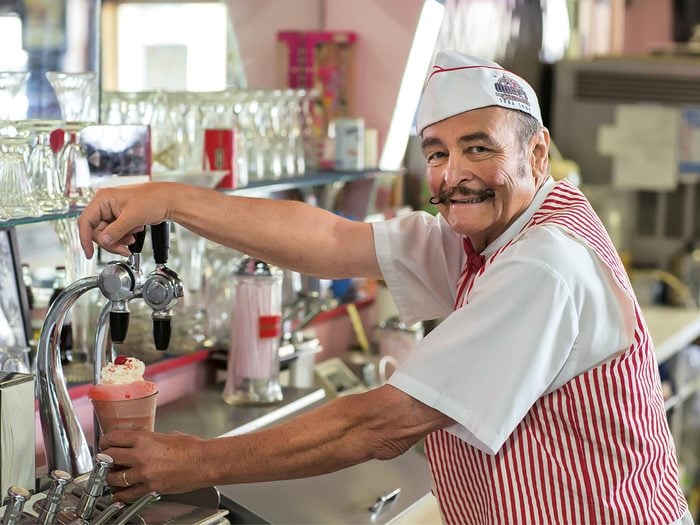
Alberta
Prehistoric adventures for the whole family
Before heading millions of years back in time from Calgary to the dinosaur age in Drumheller, start with a meal at 1950s-style Marv’s Classic Soda Shop in Black Diamond. Located south of Calgary, it’s in the wrong direction from Drumheller, which is northeast of the city, but the trip takes you through the foothills of the Rockies. Plus, a feed at this nostalgic spot will keep you going for the two-hour drive to Drumheller.
That’s where you’ll find most of the dinosaur action. You’ll know you’re in the right place when you see the World’s Largest Dinosaur—an eight-storey fibreglass-and-steel T. Rex. But the jewel in the crown is the renowned Royal Tyrrell Museum. It boasts more than 800 fossils and one of the world’s largest displays of full dinosaur skeletons. Before leaving Drumheller, take a walk along Hoodoos Trail. These geological wonders are tall sandstone shafts formed by millions of years of erosion.
About 160-kilometres southeast is Dinosaur Provincial Park, a UNESCO World Heritage Site. In these picturesque badlands, researchers have so far found the skeletons of more than 35 different species of dinosaurs dating back 75 million years. They include some of the most important fossil discoveries from the Age of Dinosaurs. You can even roll up your sleeves and participate in a guided excavation.
Find out where you can see dinosaur fossils in every province.
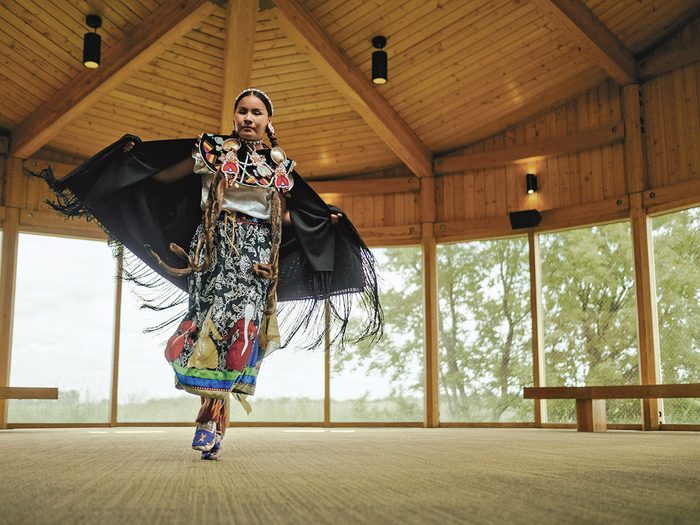
Saskatchewan
Discovering Indigenous artifacts and a key battleground site
In Saskatchewan, you’ll find vibrant Indigenous nations with traditions that date back thousands of years. A good place to start exploring the land of living skies, as declared on the province’s licence plates, is Saskatoon. The art exhibits at Remai Modern set the scene, rooted as they are in the land, and include everything from Indigenous perspectives on the Great Plains to intricate and lovely Métis beadwork.
Just to the north is Wanuskewin Heritage Park, a remarkable cultural centre where you can witness drum dancing and traditional Métis fiddling. If you have time, book a Han Wi Moon Dinner at the park. How atmospheric it is to sample the multi-course meal with Indigenous roots served on top of a bluff overlooking a river, and followed by a fireside storytelling.
About a 45-minute drive to the north is the Duck Lake Regional Interpretive Centre, where you can see photography exhibits and firsthand accounts of history through both pioneer and Indigenous perspectives. There’s also a seven-storey tower you can go up for sweeping views of the landscape.
Roughly 30 minutes away is Batoche National Historic Site, a key battleground of the North-West Resistance—a five-month uprising of Métis and their First Nations allies against the Canadian government. Here, guides will walk you through the 19th-century Métis history of the area, the lives of its leaders Louis Riel and Gabriel Dumont, the 1885 battle and its aftermath.
If you want to see the largest free-roaming herd of bison still in its original territory, Prince Albert National Park is a minor detour.
This gorgeous gallery celebrating the Canadian Prairies will have you packing your bags.
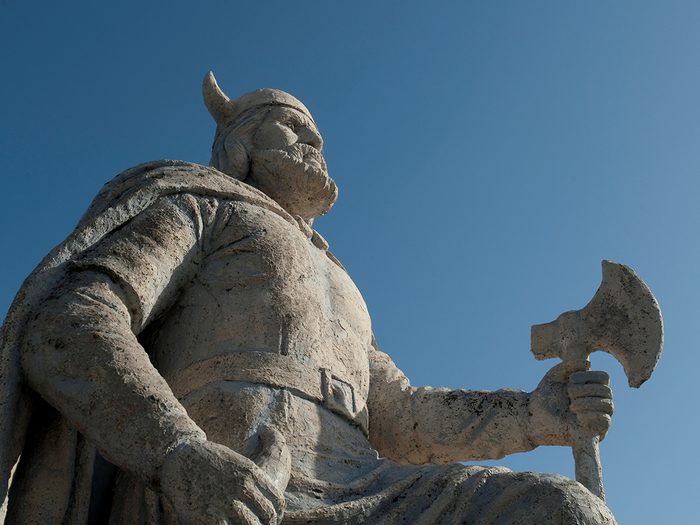
Manitoba
A taste of old Scandinavia
When it comes to quirky and cool little towns with strong links to their settlers’ homelands, Manitoba has options, especially in the Interlake region. That’s where Lakes Winnipeg and Manitoba, and countless small lakes, attract beachgoers in summer.
Start by heading to Erickson, 250 kilometres west of Winnipeg. In this tiny town, the language and culture of its 19th-century Swedish and Norwegian settlers are alive and well; shops sell Scandinavian treats like lingonberry jams and kringle pastries. There’s even a model Viking ship on Main Street that you can climb into.
Nearby, Riding Mountain National Park has the highest point between the Appalachians and the Rockies. In the park, stop in the postcard-perfect village of Wasagaming, set on the blue waters of Clear Lake. It’s home to classic motels, good restaurants and the Park Theatre, the largest log-cabin movie theatre in North America.
Looping back to the Interlake region, on the way east to Gimli you must stop for a throwback meal at Half Moon Drive-In, which has been serving up hot dogs, burgers and shakes since 1938—that’s 85 years! That has to make it one of the oldest diners in this country.
And finish in Gimli, the “heart of New Iceland,” a beach town on Lake Winnipeg about 90 kilometres north of Winnipeg. Take a photo with the 4.6-metre-tall Viking statue—a bearded man crowned with a horned hat, axe in hand. If you time it right, you can watch a Viking battle re-enactment during the Icelandic Festival of Manitoba. (This year, it takes place from August 4 to 7.) Then find a restaurant to tuck into some vinarterta. A classic Icelandic treat, this layered cake usually includes almonds, plum jam and spices such as cinnamon and cardamom.
Here are the 10 places every Canadian needs to visit.
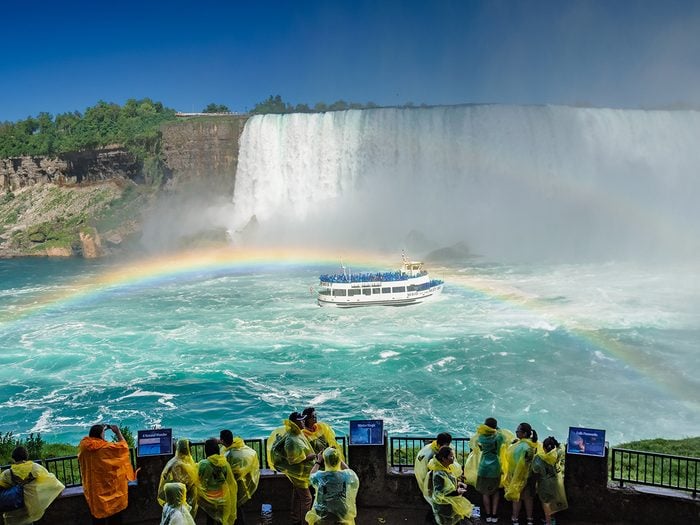
Ontario
Classic kitsch, and important history, on the Niagara Peninsula
Niagara Falls is one of the world’s most iconic sights. For more than 200 years it’s been a prime place for honeymooners (one of the most famous was the little brother of Napoleon Bonaparte), a party or a glass of good wine. If you want to see Horseshoe Falls up close as water drops over the 50-metre precipice at a rate of 2,800 cubic metres every second, put on a raincoat and see it by boat tour. Or, feel it roar past from the Journey Behind the Falls observation deck.
The fun on Clifton Hill, the steep road that begins at the edge of the falls, dates back to the 1920s, when the Foxhead Inn offered guests rooms with views of the falls for $2.25 a night. (Some 80 hotels had sprung up in the town by 1955—not long after Marilyn Monroe was there to film Niagara.) To this day, Clifton Hill maintains its old-school feel—think wax museums and carnival games. Try to conquer Dinosaur Adventure Golf, one of the largest mini putts in Canada.
But the area’s history goes beyond the kitsch and scenery: Its border location also made it a battleground. A couple of kilometres west is Lundy’s Lane, site of a major War of 1812 battle. There, you can take a self-guided walking tour that includes a visit to the Drummond Hill Cemetery, a heritage site.
And about 10 kilometres north of the falls, on the Niagara Parkway, is the excellent Landscape of Nations, on the site of the Battle of Queenston Heights. The memorial, with its limestone-walled Memory Circle and a tree of peace, honours the contributions of Indigenous nations in the War of 1812.
Discover more unique things to do in Niagara Falls.
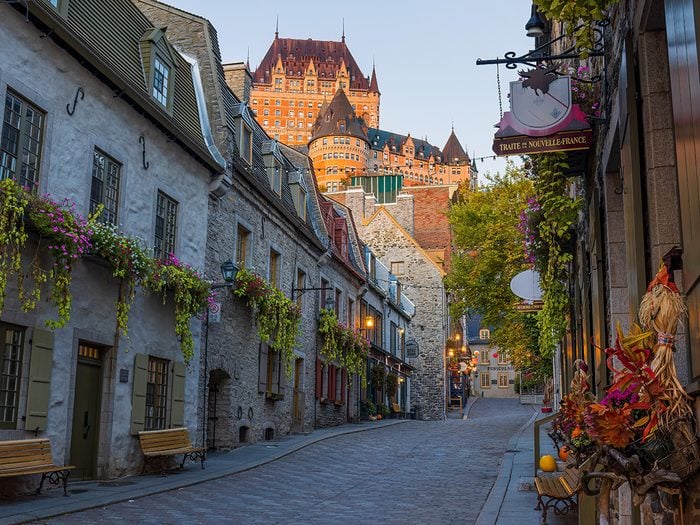
Quebec
Sailing with explorers and singing with whales along the St. Lawrence and the Saguenay
A driving tour of one of North America’s oldest European settlements starts in the most obvious place: the heart of Quebec City, founded in 1608. The best way to explore the only walled city in Canada and the United States is on foot. The place is overflowing with history, from cobblestone streets in Vieux Québec to the nearby Plains of Abraham.
Heading northeast out of town, you’ll pass Montmorency Falls and Mont-Sainte-Anne on the way to the Charlevoix region, home to the pretty town of Baie-Saint-Paul on the shores of the St. Lawrence. Some 470 million years ago, a meteor crashed in the region, leaving a crater 54 kilometres in diameter, and it’s now designated a UNESCO World Biosphere Reserve.
Travellers once arrived by steamship, but today the area is served by train in the summer. You can also cycle around the verdant area and visit its farms. Charlevoix is known for its produce, including cheeses and crisp apple ciders.
A two-hour drive farther downriver brings you to the town of Tadoussac, which is North America’s oldest French settlement—Jacques Cartier landed here back in 1535. It’s a great place for whale watching. You might see a big humpback breaching or a beluga spy-hopping just next to your tour boat on the Gulf of St. Lawrence. There are also minke, fin and blue whales, plus dolphins and seals.
Finally, drive inland to check out the stunning Saguenay fjord. The 235-kilometre Route du Fjord will take you everywhere you want to go in the long U-shaped valley, which was carved by glaciers and features cliffs as high as 350 metres rising on each side.
Explore more hidden gems in Quebec.
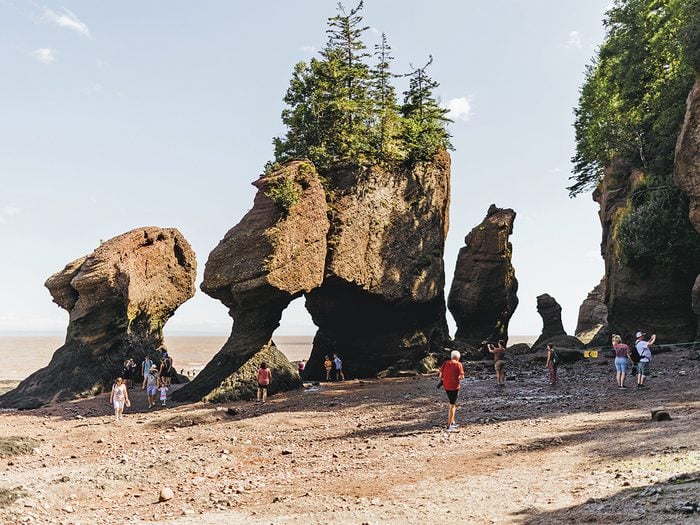
New Brunswick
Mi’kmaq culture and 320 million years of history in the cliffs of Fundy
One of the best road trips in Canada takes you to what ranks among the country’s most awe-inspiring natural wonders. And as much as you read about it before you go, nothing can prepare you for the Bay of Fundy’s massive tides. For centuries, the Mi’kmaq people paddled and navigated these tumultuous waters in birchbark canoes. Rising as much as 16 metres (the height of a four-storey building) twice a day, the drop is equally dramatic, leaving fishing boats in the harbours sitting on the bay’s floor.
The town of St. Stephen, New Brunswick (“Canada’s Chocolate Town”), close to the U.S. border with Maine, is literally a sweet way to start this road trip. Since 1873, five generations of the family-owned company Ganong have been making some of the country’s favourite chocolates.
When you’re back behind the wheel, head east for roughly two-and-a-half hours to the Fundy Trail Parkway—quite possibly Canada’s most underrated road-trip destination. Purchase a day pass to gain access to the 30-kilometre route and 2,500-hectare park. Along the way you can stop and hike to waterfalls and pull over to roadside viewpoints of sweeping vistas.
The spectacular scenery continues as you drive through Fundy National Park to Alma, a charming seaside village near the east gate. Stop here for a lobster-roll lunch on the patio at Tipsy Tails restaurant before continuing on to nearby Cape Enrage. Learn the history of its lighthouse (established in 1838), then take a guided walk down to the rocky beach, where the geology dates back 320 million years—and those massive tides reveal a constantly changing array of fossils as they erode the cliffs.
Just 30 minutes away is Fundy’s most dramatic tide-watching spot: Hopewell Rocks. Its famous flowerpots—stacks, some of which are tree-topped—have been sculpted by the ocean over the centuries.
Albert County Museum is a must-see in Hopewell Cape. The site of the 1845 “Shiretown,” or county capital, consists of eight original buildings. Exhibits retell the legends of the Mi’kmaq, including stories about the creation of the Hopewell Rocks, the giant tides on Fundy and Glooscap, a deity who lived among humans.
Check out 40 beautiful Canadian lighthouses.
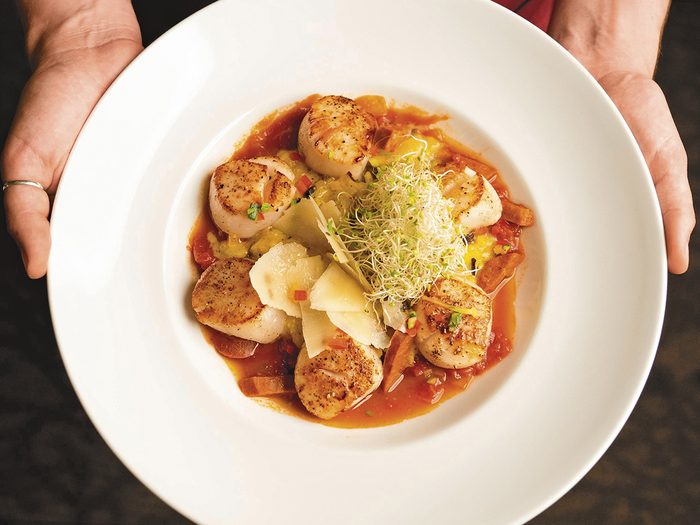
Nova Scotia
Old-time fishing villages and a taste of Acadian culture
Lunenberg, Peggy’s Cove and Cape Breton’s Cabot Trail: all are popular destinations on the east coast of Canada. But the less-visited southwestern region of Nova Scotia, between Halifax and Yarmouth, is home to some of the best road trips in Canada; full of surprising, and delicious, discoveries.
The coastal villages here have a legacy of lobster fishing dating back centuries. In tiny Tiverton, you can sail out with a guide and see how it’s done. Just 50 kilometres down the road is Digby, famous for scallops; ask around and someone will show you how to shuck one.
An overnight stay at Digby Pines Resort is like a trip back in time. When this Norman chateau opened in 1929, guests arrived by steamship and train. Its famous Stanley Thompson golf course, which you can still play, attracted famous people like Babe Ruth.
Next, continue southwest to experience this province’s Acadian culture. Today’s Acadians are descendants of 17th- and 18th-century French settlers and survivors of the Great Expulsion, when the British forced most to leave for points south (to Louisiana, for one).
At the restored École Dans l’Anse Resto Sur Mer schoolhouse you can eat rappie pie, an Acadian delicacy. For generations, the steaming dish, which combines chicken and grated potatoes, has been on tables in the region at Christmas, Easter and other occasions.
A short five-minute drive south will take you to Church Point, where you can schedule an Acadian walking tour that includes Église Sainte-Marie, the largest wooden church in North America.
Here are 10 historical landmarks every Canadian needs to visit.
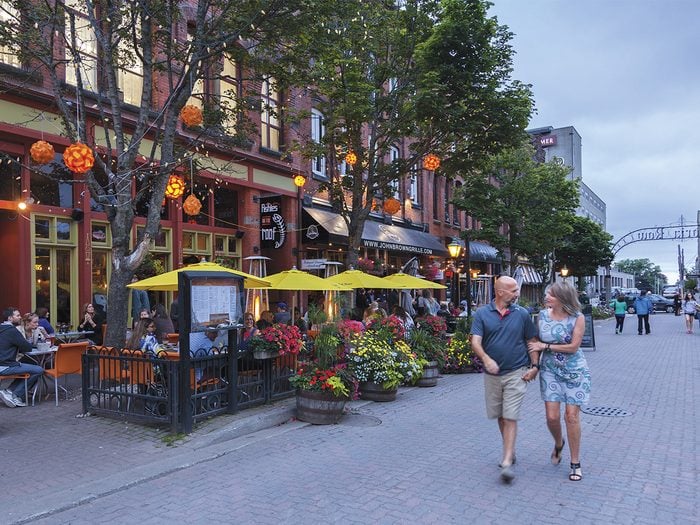
Prince Edward Island
A fictional girl comes to life—as does Canada itself
For such a small province, Prince Edward Island, the birthplace of modern Canada, pulls more than its weight. But it also has a place on the global stage, thanks, of course, to Anne of Green Gables. The 1908 book remains one of the world’s biggest bestsellers and has been translated into 36 languages. A road trip on this red-sand island makes you feel like not much has changed since Anne’s time.
In her series of Anne books, Lucy Maud Montgomery gave her hometown of Cavendish the fictional name Avonlea. Today, visitors to Avonlea Village, just outside of Cavendish, can tour an original schoolhouse and the 1872 Historic Long River Church.
Before you set out for your next stop, take a walk along Cavendish Beach, a curving eight-kilometre-long crescent of sand that’s backed by distinctive deep-red cliffs.
Historic Charlottetown is lovely in the summer, with its church steeples, lighthouses and homes painted in shades of red, blue, yellow and pink. You can visit Province House National Historic Site, where, in 1864, the Fathers of Confederation met to create a brand-new nation. Then browse the shops or grab a bite nearby at charming Victoria Row, a tree-lined pedestrian street.
The food in P.E.I. is a major plus: its mussels and oysters are exported the world over. For a traditional lobster supper, where family and friends gather at long tables, head to New Glasgow Lobster Suppers; they’ve been serving it up since 1958. You won’t even think about how silly you look in a plastic apron as you tuck into steaming homemade rolls, potato salad, seafood chowder—and lots of tasty, buttery lobster.
Here are 10 classic Canadian foods—and the best places in the country to find them.
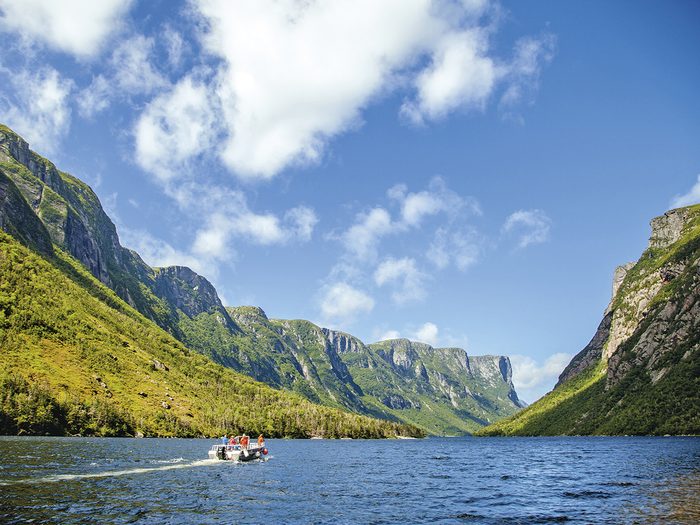
Newfoundland
Going back 1,000 years on the Viking Trail
A road trip up the Great Northern Peninsula, at the northwest end of the island, will take you back to old Norse settlements and the earliest European voyages across the Atlantic. Set off from Gros Morne National Park and head north. The two-hour drive to Port au Choix, with windswept seas to the left and the rugged Long Range Mountains to the right, will take you past colourful little fishing villages. Spend a half-day in Port au Choix; a tour of this national historic site explores the foundations of ancient settlements and a burial ground that dates back 4,000 years.
A side trip to the tiny village of Conche (population 149 at the time of writing) is worth the drive across the spine of the peninsula. It’s home to a big attraction: the 69-metre French Shore Tapestry. Designed by a French artist in 2006, the embroidery is the work of several local women and took three years to finish. Its panels tell the history of this area, including the Vikings’ arrival and the province’s confederation with Canada in 1949—marked by a beaver and a Newfoundland dog shaking paws.
Continue up the peninsula to Norstead, the re-creation of a Scandinavian village during the Viking era (circa 790 to 1066 AD). Though John Cabot first set foot in North America in 1497, the Vikings were way ahead of him: Leif Eriksson first landed here, on the northern peninsula, around 1000 AD. Norstead’s highlight is the 16-metre-long Snorri. In 1997, a team of 12 men sailed this full-scale replica of a Viking ship from Greenland to Newfoundland, re-creating Eriksson’s voyage.
Finally, head to the end of the road, the farthest north you can go on the island of Newfoundland: L’Anse aux Meadows National Historic Site. Walk the boardwalks and enter the wood and peat homes built by the Norse in the 11th century. The remains of the structures were excavated in the 1960s.
Today, costumed guides bring this legendary history to life. Take a spot by the fire and hear an epic Norse tale, perhaps about gods Thor and Loki—just like the real Vikings did more than a thousand years ago.
Now that you know the best road trips in Canada, keep an eye out for the country’s quirkiest roadside attractions.